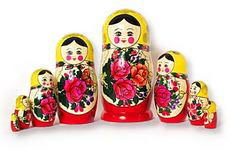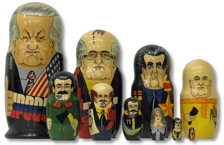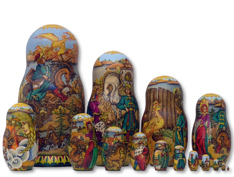Matrioska Matriosca Nesting Doll Russian Doll Origins How is Subjects Raw material Processing Etymology - MatrioskaOnLine
Main menu:
History
What is a nesting doll and how it is made

What is a nesting doll?
Matrioska or nesting doll is the term used to define the typical set of Russian dolls made in wood decorated by paints and composed of parts of different size: each one of them is insertable into the larger one.
Each piece, except the last, in the middle area has an horizontal cut so it can be opened by separating the two sides.
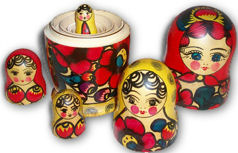
The historical origins
Its origins are to be found in Russia at the end of '800, in the
historic period of the century that marked radically the history of the country,
moving it with the October Revolution from the Zar's ancient Russia to the
future Soviet Union.
A full period of great political, social, economic and cultural
changes, that finds in the 1900 expo held in Paris the stimulus, even creative, to convey new forms of artistic
expression, of which the Russian patron Savva Ivanovich Mamontov, can be
considered an important example.
From
this wealthy and illuminated man and his court of artisans and artists, the
tradition is traced back to the invention of the nesting doll, born from the inspiration he gained after purchasing, in Japan, a statue of a character
of Buddhism and which contained inside four other smaller statues.
From this idea was born in Sergiev Posad, a town near
Moscow, the first Russian nesting doll, which was presented in
Paris and soon became a symbol of the Russian art and traditions.
The etymology of the term is not very accurate, but it can be
referred to the Russian name "Matryona" that comes from the Latin
"mater" (mother) and "matron" (woman and mother
of honest and high principles).
"Nesting doll" unfortunately, is not a universal word
because every country adopts its own translation or simplification, and to make
things more difficult it’s hard to
define a precise and unambiguous term,
often it replaced the" i "with" y "and sometimes is even omitted.
Italian : Matrioska o Matriosca
French : Russe poupée
German : Russische puppe
English : Nesting dolls o Stacking dolls
Russian : Babushka o Matrjoschka o Matryoshka
Others : Matrioska, Matrioshka, Babuschka, Matriochka, Matrochka, Matryoshka
German : Russische puppe
English : Nesting dolls o Stacking dolls
Russian : Babushka o Matrjoschka o Matryoshka
Others : Matrioska, Matrioshka, Babuschka, Matriochka, Matrochka, Matryoshka
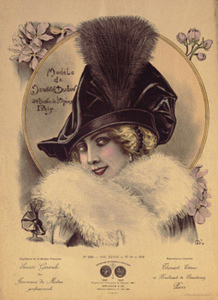
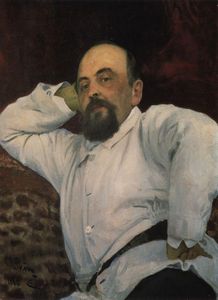
How is a nesting doll
The raw material is lime
wood. This plant provides a very easy wood to work in all directions with no
need to follow woodgrain. Also this type of wood can boast a specific weight which is minor than the one of other plants; thus making the product lighter; furthermore, this plant is widely spread around Russia. Other rarely used woods for the creation of dolls are birch and
alder.
From wood processing is obtained the rough
product which undergoes a first treatment with glues which are spread
over the entire surface to make it homogeneous and provide a basis for a first
painting.
Next step is making the surface perfectly smooth by polishing it.
After this preparatory phase, the artistic production can start,
using tempera or acrylics paints, and in some cases covering parts of the dolls
with gold foil or other precious materials to make them more valuable.
At the end, to guarantee protection to the painting, several layers of lacquer are layed to protect it from light, dust
and fingerprints; it
also gives a beautiful effect of
transparency and shine.
This last step of lacquering is sometimes not performed. The
reasons may be the simple will to save materials and work, or for a specific artist's choice. In this case the nesting doll
will appear opaque and less bright in colours.
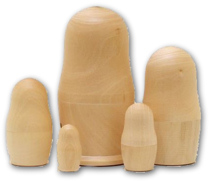
Subjects of nesting dolls
A lot of subjects are represented in the nesting dolls. The most common represents a woman dressing the traditional smock painted with big flowers and with her head covered by a veil. The main colours are yellow, red and green with lively and brilliant tones.
These kind of nesting dolls are the most commonly found on stalls and are the typical souvenirs bought by those who travelled in Eastern Europe; the economic and artistic value of these nesting dolls are actually quite poor.
Frequent nesting dolls type represents characters of history, religion and current events such as political leaders, saints of the Christian or Orthodox tradition up to musical groups.
A typical and very overplayed nesting doll example presents all Russian political figures from the recent Putin or Yeltsin to continue with smaller pieces for Gorbachev to end with the last smallest depicting Lenin.
By the way ... the former is called "mother", the latter is called "seed".
Very frequent are dolls that portray the traditional Russian women replacing the anonymous floral picture by most varied subjects coming from stories of tradition or the Russian folckore. The story is well told through the unfolding of the paintings from the first doll to the smaller one.
A last type completely eliminates anthropomorphic references, to be able to use the entire area to paint freely any type of subject.
A nesting doll is composed by a variable number of pieces that can be from a minimum of 3 to reaching over 30 pieces. A medium-sized nesting doll high 20 to 30 cm. and it is composed from 5 to 10 pieces.
